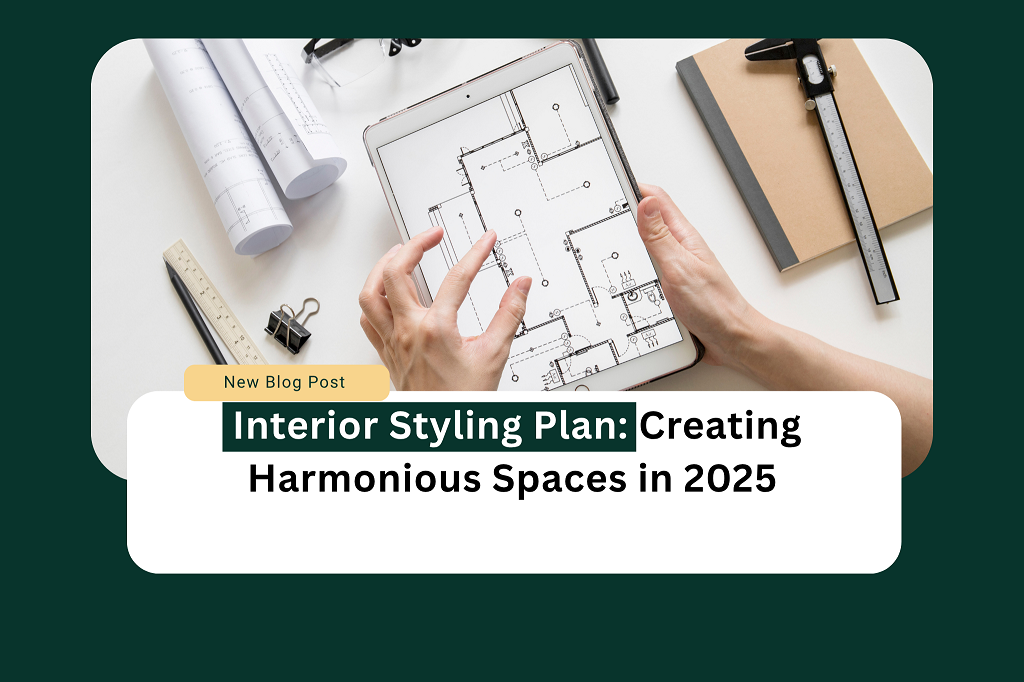Introduction
Exterior styling remains essential for creating functional areas, comfortable living spaces, and aesthetic appeal in residential and official buildings. According to Grand View Research reports the world interior design market will generate $255.4 billion by 2027, with an annual growth rate of 7.8%. The market growth demonstrates that people now understand how their surroundings shape their health status, productivity, and quality of life.
Understanding the Fundamentals of Interior Styling
Evaluating interior styling demands proper planning as a foundation for creating successful designs. The system requires space evaluation, functional need assessment, and budget setup before designers create unified design approaches. Interior design experts at the American Society of Interior Designers show that stylish areas boost real estate worth by 5-10% while promoting major enhancements in mental health among occupants. Professional designers allocate 78% of their efforts to achieving both functional design and visual beauty in their work.
Current Home and Office Interior Styling Trends
Several innovative interior styling trends emerged during the previous years and will continue their development up to 2025. The Human Spaces study shows biophilic design has gained 64% more popularity since professional designers began using it in interior spaces. The implementation of this technique creates visual appeal along with superior air quality while it decreases stress levels and improves cognitive performance. Remote work has established itself as a permanent feature in 86% of organizations that provide flexibility options and multifunctional spaces have gained popularity because of it.
Home Interior Styling Plan Essentials
To develop a thorough home interior styling plan one must focus on different fundamental areas. To determine the most efficient room design you should evaluate both purposes and walkways in every space. The Journal of Environmental Psychology reports that properly designed spaces can lower stress markings by 15% while boosting emotional well-being because they blend wellness and practicality for relaxation.
Living spaces require the establishment of separate activity zones that should connect visually with the entire area. The space requires three types of lighting including ambient for background illumination and task and accent spotlighting which creates specific areas for different functioning needs and ambiance changes. The industry has found that correct illumination techniques produce a 20% boost in mood levels while boosting home office production rates.
The essential elements for bedroom design should include elements that create a comfortable atmosphere along with peacefulness. The bedroom design plays a crucial role in sleep quality, as reported by the National Sleep Foundation because the color scheme and lighting combined with furniture placement determine both the speed of falling asleep and overall restfulness during sleep. A comfortable bedroom environment stands as a primary factor for Americans who want better sleep quality because 73% of them say this is essential.
Office Interior Styling Plan Strategies
The design of office interiors should create equal alignment between productivity requirements and employee health goals as well as brand messaging visualization. An analysis conducted by Steelcase shows that well-planned office environments boost work productivity rates by up to 16% and raise staff contentment levels by 30%. Organizations dedicated to well-being-oriented design achieve 21% higher employee loyalty and 31% reduced absenteeism figures. Activity-based working zones in an Home and Office Interior Styling Plan help support various work activities such as independent work and team collaboration.
Budget Optimization for Home and Office Interior Styling Plans
Any Home and Office Interior Styling Plan requires a realistic budget for its successful implementation. Industry statistics indicate that organizations should distribute their budget by impact and visibility standards because seating expenditures reach 20-25% since they deliver substantial returns on comfort and productivity. The budget allocation for lighting should amount to 15-20% of total funds since lighting plays a large role in mood regulation and concentration.
The budget extends more effectively when implementing projects over multiple periods. The strategic reuse of existing components brings the dual advantages of economic benefits and sustainability performance. Furniture reuse and repurposing activities enable the United States to avoid generating 8.5 million tons of waste yearly, according to data from the Environmental Protection Agency.
Implementation Timeline for Home and Office Interior Styling Plans
When you create realistic timelines for your interior styling plan, it controls expectations and aids the smooth delivery of your project. Standard industry practice shows that interior styling projects need 2-4 weeks for assessment and planning 3-6 weeks for design development and 4-12 weeks for procurement before moving into installation, which takes 1-4 weeks and refinement lasting 1-2 weeks.
A comprehensive assessment process must perform space analysis and identify functional needs together with budget formation. Project Management Institute statistics show that detailed needs assessment becomes a requirement for achieving success in interior design projects since they reach 92% of all successful outcomes. The upfront planning expenditure results in lower costs and shorter delays that occur when implementing new designs.
Sustainable Approaches to Home and Office Interior Styling
Home and Office Interior Styling Plan now focus on sustainability as their fundamental organizing principle. Nielsen’s market research reveals global consumers would absolutely or likely modify their buying patterns to decrease environmental effects according to 73% of respondents. Interior design consumers now make sustainable sourcing and eco-friendly materials their primary considerations when selecting design elements for their spaces since 78% of them have adopted this practice.
The implementation of sustainable interior styling requires selecting certified materials with FSC certification for wood products along with specifying energy-efficient lighting solutions that use LED technology which reduces energy usage by 75% compared to incandescent lighting and zero-VOC finishes for improved indoor air quality.
Personalizing Your Interior Styling Plan
Successful interior styling plans require consideration of both established best practices and individual needs and personal choices. Personalized interior elements have become more achievable through mass customization technologies since 71% of consumers show a willingness to pay additional costs for customized design features. Personalized solutions from direct-to-consumer interior design brands have experienced a 53% surge thus driving their market expansion.
Personal items that express your history should be included when developing home interior styling plans. According to the Journal of Environmental Psychology, research shows that spaces that display personal identity elements create feelings of comfort together with psychological well-being. AFF offers custom personalization features in structured environments which leads to higher employee satisfaction reaching up to 32% in the workplace.
Conclusion
The development of efficient home and office decoration schemes demands careful evaluation of workspace requirements combined with aesthetic goals and financial concerns as well as environmental priorities. Understand modern trends and use research-supported methods to develop customized solutions that help create balanced settings that improve personal wellness together with workplace performance and general quality of life.
A perfectly executed interior styling design will turn dull spaces into exceptional environments with inspirational qualities. We welcome your feedback about this article and we ask you to share this content on your social networking sites to support others in their interior design development.
FAQs
1. How much profit does typical interior decoration spending typically generate?
Professional interior design work results in residential property value increases of 5-8%, commercial spaces achieve productivity rises of 15-30%, and employee satisfaction improvements of 15-30%.
2. What approach should I use to add current trends into designs that will stay modern?
According to industry standards, the 70/30 rule should be followed for interior design because it specifies that timeless elements should occupy 70% of the space while trend-influenced components should make up 30% of the design.
4. How long does a typical interior styling project take?
From assessment to completion, most projects require 10-28 weeks, depending on scope, material availability, and complexity.
5. What elements deliver the highest impact for limited budgets?
Focus on lighting (impacts perception significantly), statement furniture pieces, and strategic color selection for maximum visual impact.
Read More : Rideshare and transportation startup plan








